Search
Search for "click":
(Click here to search this entire website for "click" with Google.)
 |
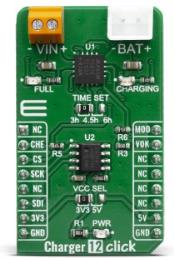
|
|
Charger 12 Click is a single lithium-ion (Li+) cell or three-cell NiMH/NiCd battery charger. This click can be used for Low-Cost Li-Ion battery chargers, or Power Tools, toys, backup energy storage solutions, etc. Charger 12 click is based on MAX1501 controller which has some extra features enabling charging without too much hassle. This click board has charging current control which uses SPI interface through MCP4161 IC, which is an 8-bit digital potentiometer. On the board, there is a Power LED and two extra LED's which can be used for charging indications.
Charger 12 click is supported by a mikroSDK compliant library, which includes functions that simplify software development. This Click board™ comes as a fully tested product, ready to be used on a system equipped with the mikroBUS™ socket.
|
|
|
|
 |
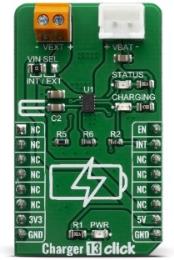
|
|
Charger 13 Click is a single lithium-ion (Li+) cell battery charger. This click can be used for Low-Cost Li-Ion battery chargers, or Power Tools, toys, backup energy storage solutions, etc. Charger 13 click is based on the RT9532GQW battery charger IC, which has some extra features enabling charging without too much hassle. This IC has an internal switching-mode regulation with input current limiting, allowing it to use an external power supply from a cheap wall adapter, rated up to 28V. On the board, there is a Power LED and two extra LED's which can be used for charging indications.
Charger 13 click is supported by a mikroSDK compliant library, which includes functions that simplify software development. This Click board™ comes as a fully tested product, ready to be used on a system equipped with the mikroBUS™ socket.
|
|
|
|
 |

|
|
Comparator click, carrying the LM2903 IC, which has two independent precision voltage comparators. Two pairs of screw terminals allow you to connect separate inputs (additional two screw terminals are for GND connections). You can use it either with a single (range of 2.0 VDC to 36 VDC) or dual power supply (from ± 1.0 VDC to ±18 VDC). Two potentiometers are placed between the terminals and the IC. Each input has its own Interrupt pin on the mikroBUS socket (one on the INT pin, the other in place of the mikroBUS AN pin), marked 01 and 02. |
|
|
|
 |
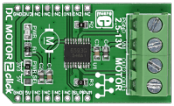
|
|
DC MOTOR 2 click carries the TB6593FNG driver IC for direct current motors. With two pairs of screw terminals (power supply and outputs), the click board can drive motors with voltages from 2.5 to 13V (output current of up to 1.2 amps with peaks up to 3.2 amps). The PWM signal drives the motor while the IN1 and IN2 pins provide binary direction signals that set the direction of the motor (clockwise or counter clockwise), or apply stop or short brake functions. Stop mode cuts off the power supply so the motor continues spinning until it runs out of momentum. Short break brings it to an abrupt stop. |
|
|
|
 |

|
|
DC MOTOR 3 click is a mikroBUS™ add-on board with a Toshiba TB6549FG full-bridge driver for direct current motors. The IC is capable of outputting currents of up to 3.5 A with 30V, making it suitable for high-power motors.
Two pairs of screw terminals are positioned on the top of the board. One is for bringing an external power supply; the other is for connecting a motor.
TB6549FG has four operating modes: clockwise, counter-clockwise, short brake and stop. The operating mode is configured through IN1 and IN2 pins. A separately controlled standby mode is also available.
For safety, the TB6549FG IC incorporates overcurrent protetciont and a thermal shutdown circuit.
The click communicates with the target MCU through the mikroBUS™ PWM pin, with additional functionality provided by IN1, IN2 and SLP pins (in place of default mikroBUS™ AN, RST and CS pins). Designed to use a 3.3 power supply only. |
|
|
|
 |

|
|
DC MOTOR 4 click is capable of driving motors with a supply voltage from 4.5V to 36V. It carries the MAX14870 motor driver from Maxim Integrated.
The click is designed to run on either 3.3V or 5V power supply. DC MOTOR 4 click communicates with the target MCU over the following pins on the mikroBUS™ line: PWM, AN, CS, and INT. |
|
|
|
 |
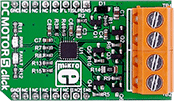
|
|
DC MOTOR 5 click carries the DRV8701 brushed DC motor gate driver from Texas Instruments.
The click is designed to run on an external power supply. It communicates with the target MCU over the following pins on the mikroBUS™ line: AN, RST, CS, PWM, and INT. |
|
|
|
 |
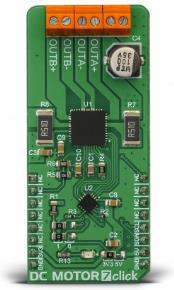
|
|
DC MOTOR 7 click is a dual brushed DC motor driving Click board™, featuring the advanced PWM chopper-type integrated DC motor driver, labeled as TB67H400AFTG. This IC can drive two brushed DC motors independently, using a wide range of supply voltages, while delivering reasonably high current to the connected DC motors. This is possible due to the low resistance of the integrated H-Bridges. In addition to being able to drive two independent DC motors, it can be used in a so-called large mode to drive a single motor, utilizing both bridges in parallel. This effectively doubles the amount of current it can deliver to the DC motor.
The Click board™ is supported by the mikroSDK compliant library, which includes functions that simplify software development. The Click board™ comes as a fully tested product, ready to be used on a system equipped with mikroBUS™.
|
|
|
|
 |

|
|
DC Motor 8 click is a DC motor driver. It can drive simple DC motors with brushes, providing them with a significant amount of current and voltage up to 40V. The click has one control input, that uses the PWM signal from the host MCU. It uses the half-bridge topology to regulate the speed of the motor rotation, employs advanced dead-time circuitry that monitors the output stage, providing maximum switching efficiency and features an advanced technique to avoid shoot-through currents.
Features, such as high-efficiency factor, low overall power consumptions and complete isolation of the output stage, enable this device to be used in various battery operated handheld tools, fans and in general - whenever a powerful and reliable DC motor driver is required. |
|
|
|
 |
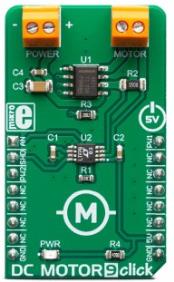
|
|
DC Motor 9 Click is a brushed DC motor driver with the current limiting and current sensing. It is based on the DRV8871, an integrated H-Bridge driver IC, optimized for motor driving applications. It can be operated by two logic signals, allowing to drive the connected motor in two different ways: it can use fixed logic levels for the direction control, or it can be controlled by a PWM signal, offering an additional speed control option. The DRV8871 also contains a set of protection features, offering a very high level of reliability. Besides driving capabilities, DC Motor 9 click can also sense current consumption at its output.
DC Motor 9 Click is supported by a mikroSDK compliant library, which includes functions that simplify software development. This Click board™ comes as a fully tested product, ready to be used on a system equipped with the mikroBUS™ socket.
|
|
|
|
 |
|
<< First
< Previous
Next >
|
|

